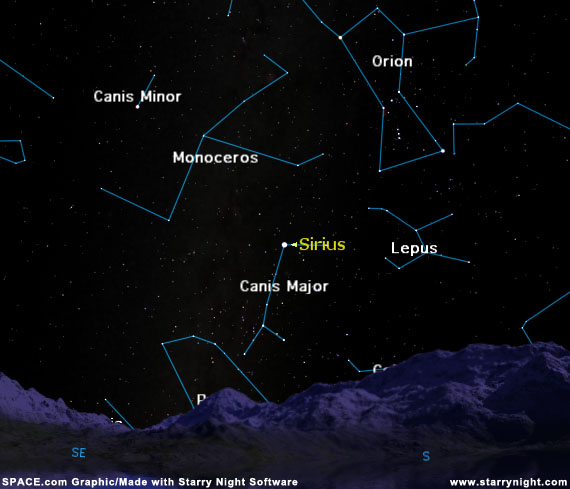
As darkness descends this week, cast a glance over toward the east-southeast and you will see a brilliant, bluish-white star scintillating just above the horizon. You'll be looking at the brightest star in the sky, the Dog Star, Sirius.
Sirius is the brightest star of the constellation Canis Major, which is Latin for the "Greater Dog." Among all the visible stars, Sirius is one of only four stars of negative magnitude (-1.44). The lower the figure of magnitude, the brighter the star.
Of the 21 brightest stars, twelve are considered to be of first magnitude, and five are of zero magnitude. But only Arcturus, Alpha Centauri, Canopus and Sirius are bright enough to be assigned a magnitude value lower than zero, or of a negative magnitude.
According to Burnham's Celestial Handbook other names for Sirius include "The Sparkling One" or "The Scorching One." The star normally appears a brilliant white with a tinge of blue, but when the air is unsteady, or when it is low to the horizon it seems to flicker and splinter with all the colors of the rainbow. At a distance of just 8.7 light years, Sirius is the fifth-nearest known star. Among the naked-eye stars, it is the nearest of all, with the sole exception of Alpha Centauri.
Many astronomy books suggest you can locate Sirius by using the belt of Orion; that the belt points southeast directly toward Sirius. Of course, that is absolutely true (in fact, following the belt in the other direction takes you to another first magnitude star, Aldebaran, in Taurus, the Bull). Of course, being the brightest star in the sky has its advantages. It's almost impossible to overlook as it gleams in the southeastern evening sky these frosty evening.
If you're still uncertain about what you are seeing and want to make a positive identification, then by all means, use Orion's belt to verify that you're indeed looking at Sirius.
Sirius will be due south between 9 and 9:30 p.m. local time all of this week, and doesn't set below the west-southwest horizon until after around 2:15 a.m.
Get the Space.com Newsletter
Breaking space news, the latest updates on rocket launches, skywatching events and more!
Over thousands of years, Sirius appears to move in a wavy line across the sky. In 1862, Alvan G. Clark first saw Sirius B, also known as "the Pup," the companion star responsible for the wiggle. Sirius B is only one ten-thousandth as bright as Sirius A, but by 1914, spectroscopic observations had demonstrated that its temperature was about the same.
From physical laws it follows that B emits the same amount of light per unit surface area as A, therefore to be so dim it must be very small. Later calculations have shown that A has just over twice the mass as our Sun, but B has nearly one solar mass. Since it is so small, B must be exceedingly dense.
In fact, it packs 98 percent of one solar mass into a body just 2 percent of the Sun's diameter. To do that, Sirius B must have a density 90,000 times that of the Sun.
Unbelievably, just a teaspoon of this star's material would weigh about 2 tons!
Basic Sky Guides
- Sky Calendar & Moon Phases
- 10 Steps to Rewarding Stargazing
- Understanding the Ecliptic and the Zodiac
- False Dawn: All about the Zodiacal Light
- Reading Weather in the Sun, Moon and Stars
- How and Why the Night Sky Changes with the Seasons
- Night Sky Main Page: More Skywatching News & Features

Starry Night software brings the universe to your desktop. Map the sky from your location, or just sit back and let the cosmos come to you.

Joe Rao serves as an instructor and guest lecturer at New York's Hayden Planetarium. He writes about astronomy for The New York Times and other publications, and he is also an on-camera meteorologist for News 12 Westchester, New York.
Join our Space Forums to keep talking space on the latest missions, night sky and more! And if you have a news tip, correction or comment, let us know at: community@space.com.

Joe Rao is Space.com's skywatching columnist, as well as a veteran meteorologist and eclipse chaser who also serves as an instructor and guest lecturer at New York's Hayden Planetarium. He writes about astronomy for Natural History magazine, the Farmers' Almanac and other publications. Joe is an 8-time Emmy-nominated meteorologist who served the Putnam Valley region of New York for over 21 years. You can find him on Twitter and YouTube tracking lunar and solar eclipses, meteor showers and more. To find out Joe's latest project, visit him on Twitter.